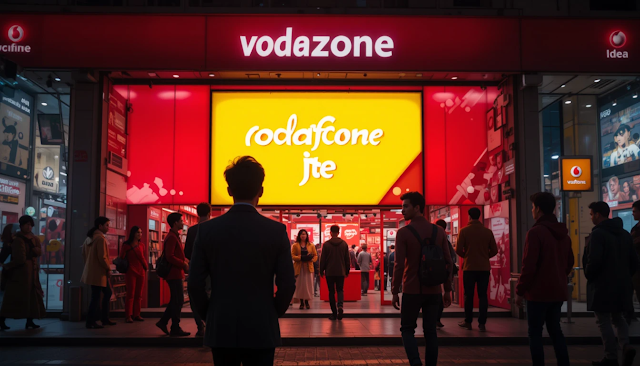Vodafone Idea (Vi), once hailed as a strong contender in India’s fiercely competitive telecom market, is now teetering on the edge of insolvency. The crisis has evolved over several years, but as of mid-2025, the situation has become dire enough to prompt fresh legal action, urgent appeals to the government, and renewed concerns from shareholders, consumers, and the broader business community.
In this post, we explore the reasons behind Vodafone Idea’s financial troubles, the recent developments in its efforts to survive, the implications for India’s telecom sector, and what the future might hold.
A Brief Background: How Did Vi Get Here?
Vodafone Idea Limited was formed in 2018 through the merger of Vodafone India and Idea Cellular, creating India’s third-largest telecom operator. The merger aimed to create synergies, reduce costs, and fight competition from the then-new entrant Reliance Jio.
However, despite these goals, the company struggled almost immediately due to:
- Intense price wars sparked by Jio’s ultra-low tariffs,
- High debt burden from spectrum acquisitions and infrastructure costs,
- Legacy liabilities from pre-merger operations,
- Regulatory challenges, especially related to Adjusted Gross Revenue (AGR) dues.
The AGR Dues Crisis: A Ticking Time Bomb
One of the most significant factors pushing Vodafone Idea toward insolvency is its massive AGR liability. The Supreme Court of India ruled in 2019 that telecom companies must pay a portion of their revenue—including non-telecom revenues—as part of license fees to the government.
This ruling resulted in an unprecedented ₹58,254 crore liability for Vodafone Idea.
While the government later provided a four-year moratorium (until 2025) on AGR and spectrum payments, it did not waive the dues or reduce penalties and interest, which continued to accrue.
As the moratorium nears its end, Vi finds itself in a precarious position:
- Owes over ₹30,000 crore in penalties and interest on AGR dues.
- Required to pay ₹12,000 crore between September 2025 and March 2026.
- Expected to pay ₹43,000 crore annually from FY27 to FY31.
The Legal Route: Vi’s Petition to the Supreme Court
In a last-ditch effort to stay afloat, Vodafone Idea has filed a fresh petition in the Supreme Court seeking a waiver of over ₹30,000 crore in AGR dues. This includes primarily the interest and penalties, which the company argues are unsustainable under the current economic climate.
The hearing is scheduled for May 19, 2025, and could be a turning point. A favorable verdict could save the company from insolvency, while a rejection might force it to initiate insolvency proceedings through NCLT (National Company Law Tribunal).
The Government’s Role: Equity Conversion and Beyond
The Indian government, recognizing the critical role Vi plays in maintaining a three-player telecom market, took an unprecedented step in early 2024. It converted ₹36,950 crore of Vi’s debt into equity, acquiring a 49% stake in the company.
While this move temporarily eased Vi’s financial stress, it hasn’t solved the core problem: cash flow to meet future obligations.
Despite a recent ₹26,000 crore fundraise, Vi has stated it is not receiving adequate bank support. Without new long-term financing or government guarantees, Vi says it cannot sustain operations beyond FY2025–26.
Market Reactions and Shareholder Sentiment
In the wake of these developments, Vodafone Idea’s stock has seen short-term rallies, largely driven by speculation around potential relief measures. However, analysts remain cautious, citing:
- High debt-to-equity ratio,
- Uncertain legal outcomes,
- Delayed 5G rollout,
- Negative cash flows,
- Growing subscriber losses.
Shareholders are closely watching the outcome of the Supreme Court hearing, which could dictate Vi’s survival.
Operational Challenges: Can Vi Compete Technologically?
While Jio and Airtel have aggressively expanded their 5G networks, Vodafone Idea is still in the early stages. It recently launched 5G services in Delhi NCR and plans to expand across 17 telecom circles by August 2025.
However, this comes late. Consumers have already begun switching to competitors for faster, more reliable service. As of Q1 2025, Vi’s market share has dipped below 20%.
Lack of capital for network upgrades, coupled with poor customer experience, continues to weaken the brand’s position in India’s telecom hierarchy.
Industry Implications: Why Vi’s Fall Could Be Disastrous
A potential insolvency or exit of Vodafone Idea could have wide-reaching consequences for the Indian economy and telecom sector:
1. Reduced Competition
India’s telecom sector would effectively become a duopoly—Reliance Jio and Bharti Airtel—reducing consumer choice and potentially increasing tariffs.
2. Impact on Financial Institutions
Many Indian banks are exposed to Vi’s debt. Insolvency could trigger defaults amounting to thousands of crores, affecting the health of the financial sector.
3. Job Losses
Vi employs over 10,000 directly and supports hundreds of thousands indirectly through vendors and partners. Bankruptcy would lead to substantial job losses.
4. Government Revenue Loss
The government may be unable to recover nearly ₹2 lakh crore in dues if Vi goes through NCLT proceedings.
5. Investor Confidence
The collapse of a partially government-owned company could shake investor trust in public-private sector partnerships in India.
What’s Next for Vodafone Idea?
The future of Vodafone Idea now hinges on a few critical outcomes:
- The Supreme Court’s decision on AGR relief (scheduled for May 19, 2025),
- Whether the government provides additional support (debt restructuring or guarantees),
- Whether Vi can raise fresh capital from banks or international investors,
- Consumer retention and 5G rollout success in the coming months.
If the company fails on these fronts, India may witness one of the largest telecom collapses in its history, echoing the downfall of Aircel and RCom—but with far greater economic consequences.
Conclusion
Vodafone Idea’s struggle is not just about one company—it’s about the future of competition, innovation, and fairness in India’s telecom space. Whether Vi can survive or not will depend on urgent interventions, legal outcomes, and strategic clarity in the months ahead.
Follow us for further updates on this evolving story, especially after the Supreme Court hearing on May 19, 2025.
Tags: Vodafone Idea, Insolvency, AGR Dues, Supreme Court, Telecom Industry India, Vi, Jio, Airtel, Telecom Crisis











